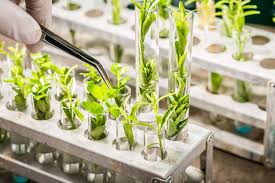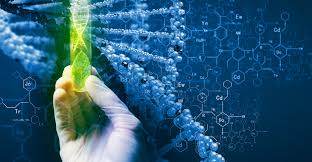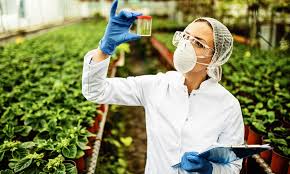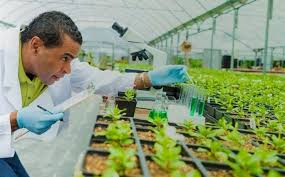Biotechnology in agriculture refers to the use of scientific techniques and innovations to improve plants, animals, and microorganisms for agricultural purposes. By combining biology and technology, agricultural biotechnology enhances crop production, improves animal health, and increases overall farming efficiency.
This field encompasses a wide range of applications, from genetically modifying plants for better yield to using microorganisms for natural pest control.
One of the main objectives of agricultural biotechnology is to develop crops that are more resilient to environmental stressors such as drought, pests, and diseases. By inserting specific genes into plants, scientists can produce crops that are not only more robust but also more nutritious.
For instance, biofortified crops like Golden Rice, which has been enhanced with Vitamin A, help address nutritional deficiencies in regions with limited food variety.
Furthermore, genetically modified (GM) crops can reduce the need for chemical pesticides, leading to more sustainable and environmentally friendly farming practices.
Biotechnology also plays a critical role in animal agriculture. Techniques such as genetic engineering and cloning are being explored to improve livestock breeds for better meat, milk, and egg production. Additionally, vaccines developed through biotechnology help prevent diseases in animals, contributing to healthier livestock and reducing the risk of zoonotic diseases.
Agricultural biotechnology offers solutions to some of the most pressing challenges in modern agriculture, including food security, climate change, and resource scarcity. By enabling farmers to grow more food with fewer resources, biotechnology helps support a growing global population.
However, this field also raises important ethical, environmental, and regulatory questions, as the introduction of genetically modified organisms (GMOs) and other biotech innovations has sparked debates about safety and sustainability.
As biotechnology continues to evolve, it holds great potential to transform agriculture and contribute to a more food-secure future.
Historical Overview of Biotechnology in Agriculture
The roots of biotechnology in agriculture can be traced back thousands of years, but modern agricultural biotechnology emerged in the late 20th century. Key milestones include:
1. Traditional Breeding: Farmers have used selective breeding for centuries to develop crops with desirable traits, such as higher yields or better taste.
2. Discovery of DNA Structure (1953): The identification of the double helix structure of DNA by James Watson and Francis Crick laid the foundation for modern genetics and biotechnology.
3. Development of Genetic Engineering (1970s): The introduction of techniques to isolate and manipulate genes marked the beginning of genetic engineering in agriculture.
4. First Genetically Modified Organism (GMO) (1982): The first genetically modified plant, a tobacco plant resistant to certain antibiotics, was developed, paving the way for subsequent developments in GMOs.
5. Commercialization of GM Crops (1990s): The first GM crops, such as Bt cotton and Roundup Ready soybeans, were introduced, leading to widespread adoption in agriculture.
Key Concepts in Agricultural Biotechnology

1. Genetic Engineering: A technique that allows scientists to directly manipulate an organism’s DNA to achieve desired traits, such as pest resistance or drought tolerance.
2. Genetic Modification: The alteration of an organism’s genetic material to produce specific characteristics. This includes adding, deleting, or altering genes within the genome.
3. Molecular Markers: DNA sequences used to identify specific traits in plants. These markers help in the selection of desirable traits during breeding programs.
4. CRISPR Technology: A revolutionary gene-editing tool that allows precise alterations in an organism’s DNA. It has the potential to improve crop traits quickly and accurately.
5. Biopesticides and Biofertilizers: Naturally derived products that can be used to control pests or enhance soil fertility, offering sustainable alternatives to chemical pesticides and fertilizers.
Types of Biotechnological Techniques Used in Agriculture
Several biotechnological techniques are commonly employed in agriculture:
1. Recombinant DNA Technology: Involves the insertion of foreign DNA into a plant’s genome to confer desired traits, such as pest resistance or improved nutritional content.
2. Tissue Culture: A technique that allows the growth of plant cells or tissues in a controlled environment, enabling the rapid propagation of disease-free plants.
3. Marker-Assisted Selection (MAS): Uses molecular markers to assist in the selection of plants with desirable traits during traditional breeding, speeding up the breeding process.
4. Synthetic Biology: Combines biology and engineering to design and construct new biological parts, devices, and systems. It holds potential for developing innovative agricultural solutions.
5. Genome Sequencing: The process of determining the complete DNA sequence of an organism. Sequencing crop genomes helps identify genes associated with desirable traits, aiding in breeding efforts.
Read Also: Dragon Fruits: History, Nutrition, Health Benefits and Growing Guide
Genetic Modification and Crop Improvement

1. Increased Yields: GM crops are engineered for higher productivity, helping to feed a growing global population. For instance, Bt corn is modified to produce a protein toxic to specific pests, leading to better yields.
2. Pest and Disease Resistance: GM crops are designed to resist pests and diseases, reducing the need for chemical pesticides and minimizing crop losses.
3. Drought Tolerance: Genetic modification can enhance a crop’s ability to withstand drought conditions, crucial for regions facing water scarcity.
4. Improved Nutritional Content: Biotechnological advancements have led to the development of biofortified crops, such as Golden Rice, enriched with vitamins and minerals to combat malnutrition.
5. Reduced Environmental Impact: By decreasing the reliance on chemical inputs and increasing crop resilience, biotechnology contributes to more sustainable agricultural practices.
Enhancing Pest and Disease Resistance Through Biotechnology
One of the most significant contributions of biotechnology to sustainable agriculture is the enhancement of pest and disease resistance in crops. Here are some key points:
1. Genetically Modified Crops: Crops like Bt cotton and Bt corn have been engineered to produce proteins that are toxic to specific pests, reducing the need for chemical pesticides. This not only lowers production costs but also minimizes environmental impact.
2. Disease Resistance: Biotechnology allows for the development of crops resistant to various diseases. For example, researchers have created papaya varieties resistant to the papaya ringspot virus, saving the industry from potential collapse.
3. Integrated Pest Management (IPM): Biotechnology complements IPM strategies by providing crops that can withstand pest pressures. This holistic approach reduces reliance on chemical treatments and promotes ecological balance.
4. Biopesticides: These are natural or biologically-derived agents used to control pests and diseases. Biopesticides can be used in conjunction with genetically modified crops, offering an environmentally friendly alternative to traditional pesticides.
5. Faster Development of Resistant Varieties: Biotechnology accelerates the breeding process, allowing scientists to introduce resistance traits more quickly than traditional methods. This is especially important in the face of rapidly evolving pest populations.
Biotechnology’s Contribution to Soil Health and Fertility
Soil health is fundamental to sustainable agriculture, and biotechnology contributes in various ways:
1. Biofertilizers: These are natural fertilizers containing living microorganisms that enhance soil fertility and plant nutrition. For example, nitrogen-fixing bacteria can improve nitrogen availability to crops, reducing the need for synthetic fertilizers.
2. Soil Microbiome Enhancement: Biotechnology enables the manipulation of soil microbes to improve their effectiveness in nutrient cycling and disease suppression. Enhancing the soil microbiome contributes to healthier plants and improved yields.
3. Reduced Chemical Inputs: By increasing crop resilience to pests and diseases, biotechnology helps reduce the reliance on chemical fertilizers and pesticides, promoting a healthier soil ecosystem.
4. Organic Matter Management: Biotechnology can help develop crops that are better at utilizing organic matter, improving soil structure and water retention, and fostering a more sustainable farming system.
5. Soil Remediation: Bioremediation techniques use microorganisms to break down pollutants in the soil, improving soil health and safety for agricultural use.
Read Also: The Anise Fruits: Economic Importance, Uses, and By-Products
Impact of Biotechnology on Crop Yield and Food Security

1. Increased Yields: Biotechnology has been instrumental in developing high-yielding crop varieties. For instance, genetically modified rice varieties can significantly increase productivity, helping to meet the demands of a growing population.
2. Enhanced Resilience: Biotechnology enables the development of crops that can withstand extreme weather conditions, such as drought or flooding. This resilience is crucial for maintaining stable food production in the face of climate change.
3. Reduced Crop Losses: By providing resistance to pests and diseases, biotechnology helps minimize crop losses, ensuring more food is available for consumption.
4. Nutritional Improvements: Biotech crops can be engineered to contain higher levels of essential nutrients, contributing to food security and improving public health.
5. Economic Benefits: Higher yields and reduced losses translate to better economic outcomes for farmers, enabling them to invest in their communities and contribute to local economies.
Regulatory Frameworks for Biotech Agriculture
The safe and responsible use of biotechnology in agriculture is governed by various regulatory frameworks:
1. National Regulations: Different countries have specific regulations regarding the development, testing, and commercialization of biotech crops. These regulations ensure that biotech products are safe for human consumption and the environment.
2. International Guidelines: Organizations like the Food and Agriculture Organization (FAO) and the World Health Organization (WHO) provide international guidelines for biotechnology, promoting safe practices and harmonizing regulations among countries.
3. Biosafety Protocols: The Cartagena Protocol on Biosafety is an international treaty that governs the movement of living modified organisms (LMOs) across borders, ensuring that countries assess and manage potential risks.
4. Public Participation: Many regulatory frameworks include provisions for public consultation and participation, ensuring that stakeholders, including farmers, consumers, and environmental groups, have a voice in decision-making processes.
5. Monitoring and Evaluation: Regulatory bodies are responsible for monitoring the impact of biotech crops on health and the environment, ensuring ongoing safety and efficacy.
Do you have any questions, suggestions, or contributions? If so, please feel free to use the comment box below to share your thoughts. We also encourage you to kindly share this information with others who might benefit from it. Since we can’t reach everyone at once, we truly appreciate your help in spreading the word. Thank you so much for your support and for sharing!
Read Also: Chicken Brooder House – Complete Chicks Brooding Care Guide






